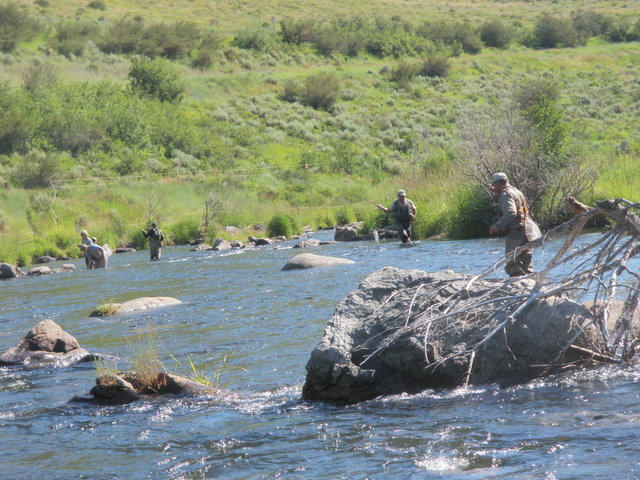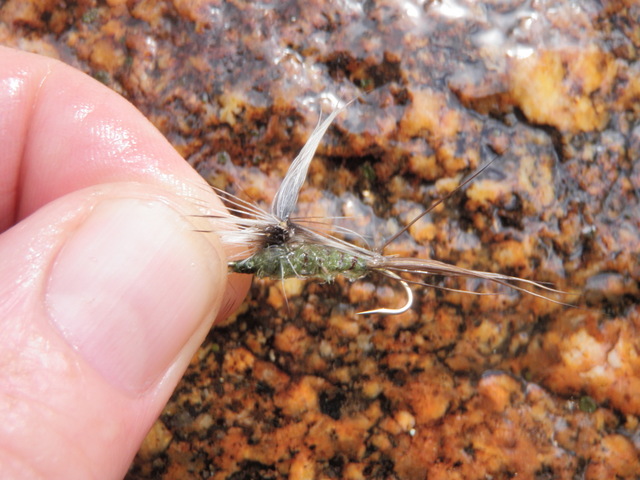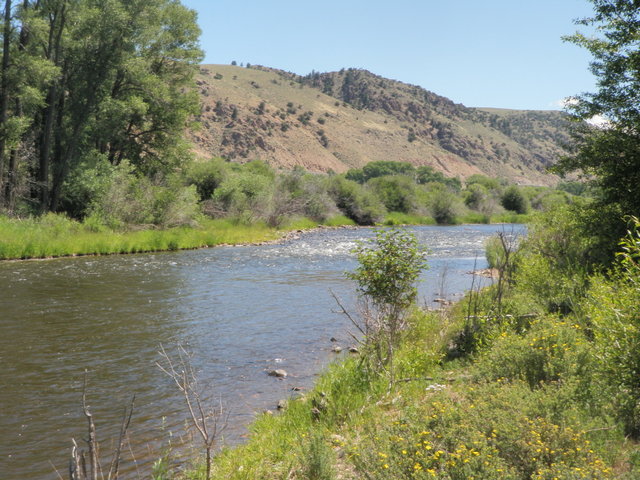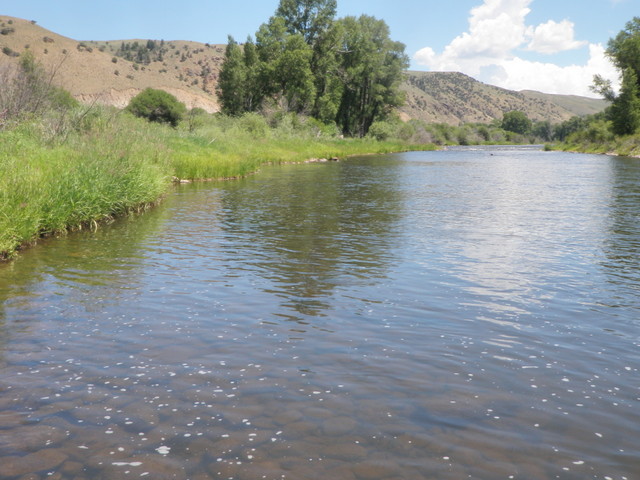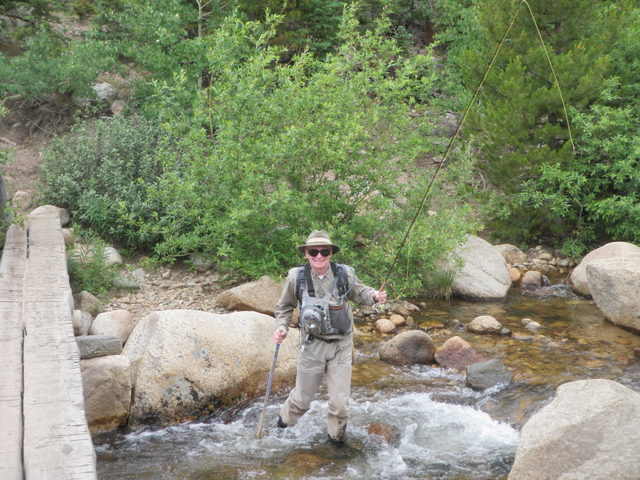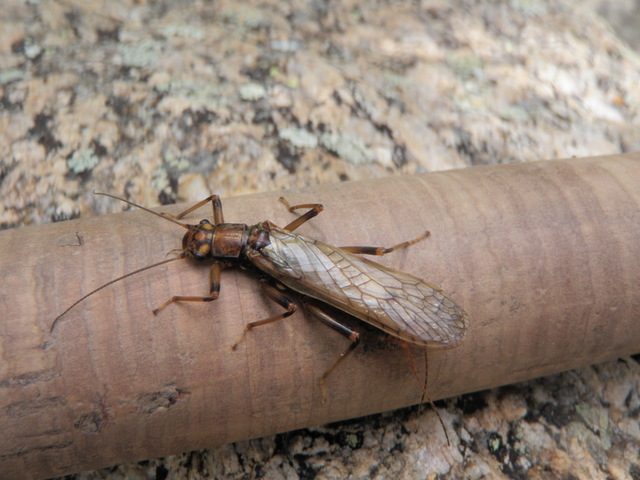Time: 10:00AM – 3:00PM
Location: A Half Hour Hike Below Gross Reservoir
Fish Landed: Dave 5; Dan 3
South Boulder Creek 07/25/2013 Photo Album
My son Dan returned to Denver after spending nearly five months in Asia, and he wanted to spend a day fishing before heading off to Durham, NC for graduate school in the Fuqua MBA program. We settled on Thursday as the best day to fit in a day of fishing. Dan had plans for most evenings, so we didn’t want to make a long trip that required two or more hours of drive time, so I researched the closer stream options.
I’ve had my eye on South Boulder Creek after some interesting visits in September and October of 2012, but the stream flows have been hovering over 200 cfs and that is relatively high for a fairly small streambed. I did notice that the flows dropped below 200 cfs to 193 a few days prior to our planned fishing venture, so I gambled this would be manageable. I felt we could do better than Clear Creek and Bear Creek on Dan’s sole fishing trip of 2013, and the Big Thompson is crowded, and the NF of the St. Vrain flows dropped precipitously thus projecting difficult fishing in my thought process.
Dan and I departed from Stapleton by 8:00AM and we did encounter a bit of morning rush hour congestion on interstate 70, but despite this hardship, we arrived at the parking lot near the dam by 9:15. The air temperature remained quite cool with quite a few large gray clouds overhead as we set up our rods and put on our waders. We packed our lunches and raincoats as I told Dan I wanted to hike quite a distance downstream on the trail.
We followed the trail all the way to its farthest point and at that location we entered the water. The sky remained overcast and Dan began with a Chernobyl ant and beadhead hares ear, and I elected to tie on a yellow Letort hopper and a beadhead bright green caddis pupa and below that a zebra midge larva as a third fly. This proved to be a mistake as I worked the right bank which required backhand casts. Backhand casts and three flies are a recipe for disaster, and I spent much of the first hour of fishing untangling some massive snarls.
Dan meanwhile was working up the left bank in expert fashion, and he landed a pair of browns on the trailing hares ear. The midge larva wasn’t producing so I replaced it with a beadhead pheasant tail, and it was this combination that produced my first fish of the day. I cast the hopper along the edge of a current seam and as it drifted back toward me the top fly paused so I set the hook and lifted my rod. Amazingly I saw two fish on my line; one on the caddis and one on the pheasant tail. The top fish freed itself fairly early in the fight allowing me to easily land the small nine inch brown that was fooled by the pheasant tail. Although it was nice to register my first fish of the day, this was probably an unfortunate incident for my long term fishing success.
The double gave me incentive to continue the three fly experiment, and that proved to be a major strategic error. Rather than connecting with multiple fish, I found myself unraveling three or four massive line snarls where I had to cut off the trailing flies and then reattach. Eventually I wised up and removed the third fly and fished the hopper and caddis until we broke for lunch at noon.
As Dan and I sat on a decaying log consuming our lunches we heard distant thunder, but since we had our raincoats, we didn’t give it much attention. After lunch I experienced a couple refusals to the yellow hopper, so I decided to make a change. Perhaps the fish were attracted by the yellow, but my fly was too large. Clearly they were looking toward the surface for their meal, so I tied on a yellow sally size 14. This proved to be a stroke of solid reasoning and within the first hour after lunch I landed another three fish and in fact I was convinced enough by the effectiveness of the yellow sally that I exited the stream and walked back across from Dan and informed him. Unfortunately he did not have any yellow sallies in his fly box so he waited until we could meet on the same side of the stream.
I returned to my point of exit as some large but well spaced raindrops began to descend from the sky. Dan and I both extracted our raincoats and prepared for the worst. Just above my reentry point there was a jumble of dead logs that created a natural dam along the right side of the stream and a fine twenty foot long pool. I dried and fluffed my yellow sally and flicked it five feet above the stick jam and almost as soon as the fly touched the water it was savagely accosted by a fish. I set the hook and watched a twelve inch rainbow leap from the water. This would turn out to be my best fish of the day.
Shortly after photographing and releasing the rainbow the storm moved over Dan and I and the interval between lightning flashes and thunder shrank to four seconds so Dan and I found locations next to large rocks and laid low for a bit. Once the thunder and lightning faded into the distance the rain intensified, but we resumed fishing. It was very difficult to keep my dry fly dry as there was moisture everywhere; dense raindrops descending from the sky, wet fingertips, no dry article of clothing to absorb moisture and of course the surface of the stream.
The rain continued to descend in sheets as Dan and I worked upstream, but the fish weren’t cooperating and we were getting wet and chilled so we decided to hit the trail and work our way back toward the car with the thought of fishing some nice pools closer to the parking lot should the rain end or diminish. The act of hiking on the path had the effect of warming our bodies somewhat, and we did stop briefly to fish a nice pool just upstream of the footbridge, but it was 3PM and our thoughts turned to dry clothes and the Cannonball Creek brewpub in Golden.
It was a fun day before the storm hit, although I wish I’d discovered the success of the yellow sally earlier. Should the flows decrease to the 150 cfs range, I will surely return to South Boulder Creek.




